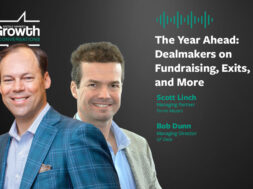Dealmaker Q&A: Aurora Capital’s Cold Chain Technologies Completes Fifth Add-on
Aurora’s Randy Moser talks about the opportunities and challenges in the life sciences transport space and how he’s driving growth at the company

Cold Chain Technologies (CCT), a thermal packaging and digital monitoring provider for transporting life sciences products and a portfolio company of Aurora Capital Partners, recently announced the acquisition of Global Cold Chain Solutions (GCCS), its fifth add-on acquisition since Aurora’s investment in 2019. Middle Market Growth spoke to Randy Moser, partner with Aurora, about CCT’s global expansion, his approach to value creation and more.
Middle Market Growth: Cold Chain Technologies recently completed its fifth add-on acquisition, Global Cold Chain Solutions, in March. When sourcing the deal, what were you looking for in a target, and how did GCCS meet those requirements?
Randy Moser: We really were looking for an Asia Pacific presence—that was really the last gap we had in our geography. When we first acquired CCT in 2019, it was primarily a U.S.-only business, and we’ve made a number of acquisitions internationally since then, and the Asia Pacific [region], particularly a presence in India, was really attractive to us. There’s a lot of growth in not only pharmaceuticals, but a lot of temperature-sensitive life science products, including vaccines, coming out of India. And so being able to increasingly serve our global customers everywhere that they operate was important for us. That was the major strategic thrust behind the deal.
MMG: Looking back to 2019, what initially attracted Aurora Capital to CCT and to the thermal packaging and life sciences transport space more broadly?
RM: What we loved about the space was that it’s a very mission-critical product serving a risk-averse customer base. The products are highly designed and customized. We spend a lot of time, many months, working with customers to understand the needs of the drug: the temperature needs, what lanes they’re going to be shipping it through, where it’s leaving, and where it’s headed. And for us, we knew there was value in having that very customized, very consultative sale. We also really liked the trends towards the increasing temperature sensitivity of pharmaceutical products, which was a trend that was already playing out in 2019. As we thought about growth in cell and gene therapies and protein-based therapeutics, we wanted exposure the growth in those markets.
We spend a lot of time, many months, working with customers to understand the needs of the drug: the temperature needs, what lanes they’re going to be shipping it through, where it’s leaving, and where it’s headed. And for us, we knew there was value in having that very customized, very consultative sale.
We also saw an opportunity to really deliver a one-stop-shop to customers where we would offer parcel solutions, pallet solutions, pallet covers, reusable single-use [products], recyclable alternatives, things like that. We thought there was a tremendous opportunity in the market to build that scaled player in this space.
When we looked at CCT specifically, this was a business that was focused on the life science market, had grown organically 20 years in a row, and had just really great feedback from customers in terms of design, engineering expertise, customer service and the performance of the products. We also had a shared vision with the founder, Larry Gordon, about how we were going to grow the business. They needed a capital partner to help effectuate add-on acquisitions; this was just something that they couldn’t do on their own. They’d also developed a really exceptional reusable parcel shipper, which is called EcoFlex, and a capital partner could help build out a fleet of those products. Sitting here in 2025, we believe we have the largest such fleet in North America now, and that’s a business that’s really grown tremendously for us. But we loved the space, and we thought CCT was the perfect platform for us to effectuate that strategy.
MMG: What are some headwinds you’re watching within this space, and how will those impact your approach to value creation?
RM: I think one thing we do pay a lot of attention to, when we’re thinking about where to spend time commercially, is that it’s a long sales cycle for customers, which is part of what makes the business so sticky. So, we put a lot of time into really understanding where the customers are in the development of a new pharmaceutical product because, as I’m sure you can imagine, you could spend a lot of time on something that then doesn’t end up going anywhere, because maybe the drug doesn’t pass clinical trials or something like that. And so, really making sure you understand the drug, where it sits in the development lifecycle, I think that’s become more of a core competency for CCT over time. It’s a long sales cycle, so you want to make sure you’re making your commercial investments in the right places.
MMG: This deal expands CCT’s Asia Pacific presence, but it’s not the first global expansion for the company. What are your best practices for integrating new regions and add-ons into the existing organization?
RM: To use a medical analogy, first ‘do no harm.’ So, we want to watch the business operate for a period of time to really make sure we understand how they do business. What’s the cadence of customer interactions? What’s the SIOP process? What’s the right forecasting protocol for this business, and is it different from how we forecast our own business? I think one of the mistakes that people make in a lot of add-on acquisition strategies is that they think the parent company always has the right strategy, so then they push the parent’s philosophy onto the add-ons. There are instances where we’ve learned things from add-ons that we’ve then ported into CCT more broadly, and I think for us, it’s important to be able to authentically tell a founder, “We really think we can be an enabling platform for you to accelerate your growth and reach more customers, and we authentically want to do what’s best for the combined organization. We’re going to spend time sitting down together, post-closing, figuring out what are the best practices that each of us bring to the table, and be able to bring the best of both worlds to the combined business.” It’s been a great strategy for us. It’s very important to make sure we don’t break what we bought. And then once we feel like we understand, okay, these are the best practices, this is how we’re going to integrate, then we do a full integration. We don’t maintain multiple brands; we don’t maintain multiple websites; it all gets consolidated under CCT and a commercially integrated back office. So, we do ultimately want to get to full integration, but we want to make sure we are learning the business so that we know how to integrate it as best we can, and not just as fast as we can.
MMG: CCT, under Aurora’s watch, distributed over 500 million COVID-19 vaccines. I imagine that was a fairly fast-moving, sensitive, and high-pressure endeavor, especially initially. Can you tell me a little bit about how that was undertaken and successfully delivered?
RM: We’ve had a longtime partnership with the CDC distributing vaccines. And for us, the opportunity to serve the U.S. this way was an honor and something we took very seriously. But we did have to add capacity very rapidly—we actually signed a lease, bought more than $10 million dollars’ worth of equipment, stood up a new production facility, and hired over a hundred people in less than three months. That was an incredible undertaking for a business our size. We have a really great operations team at CCT that pulled this off. And the timing was actually convenient because it coincided with an organic expansion we needed in the base business anyway, and so to be able to get into a larger facility, the timing actually sort of coincidentally worked out. But it took a lot for us to serve the Operation Warp Speed program, and standing up the facility was a huge piece of preparing for that.
This interview has been edited and condensed for clarity.
Hilary Collins is ACG’s Associate Editor.
Middle Market Growth is produced by the Association for Corporate Growth. To learn more about the organization and how to become a member, visit www.acg.org.


